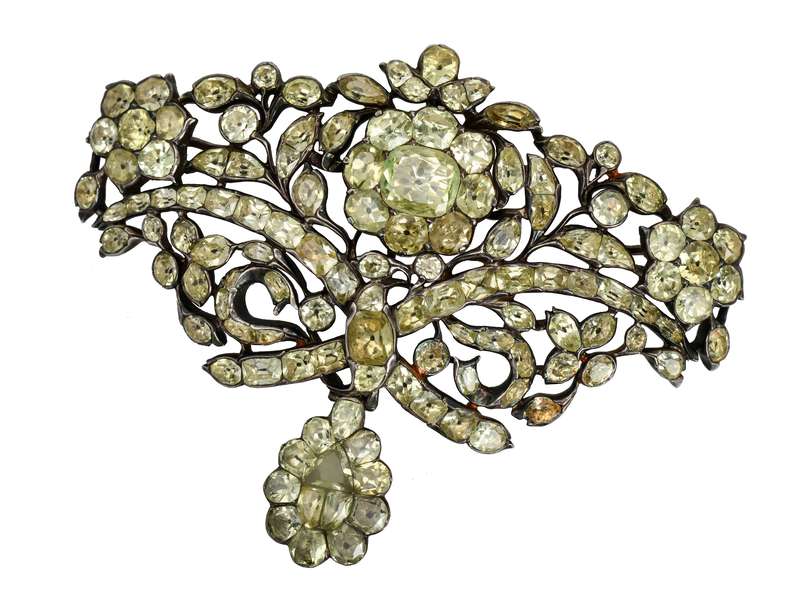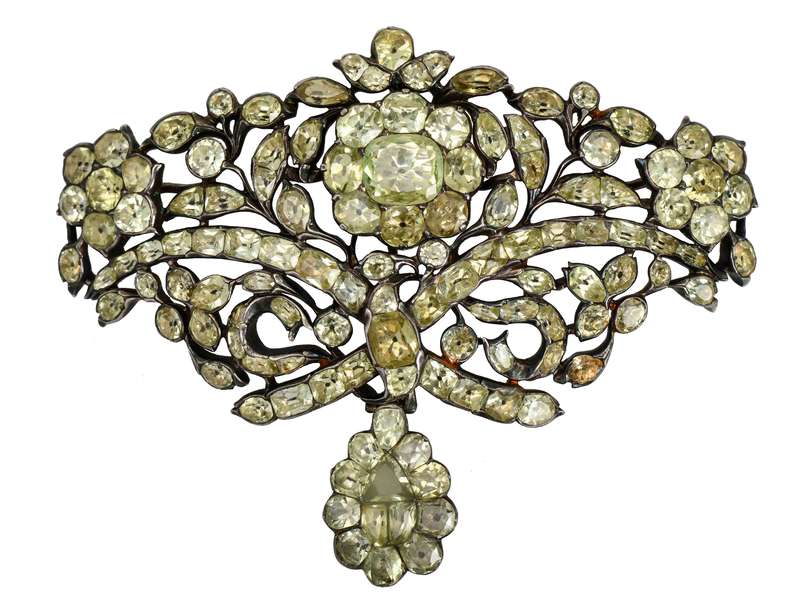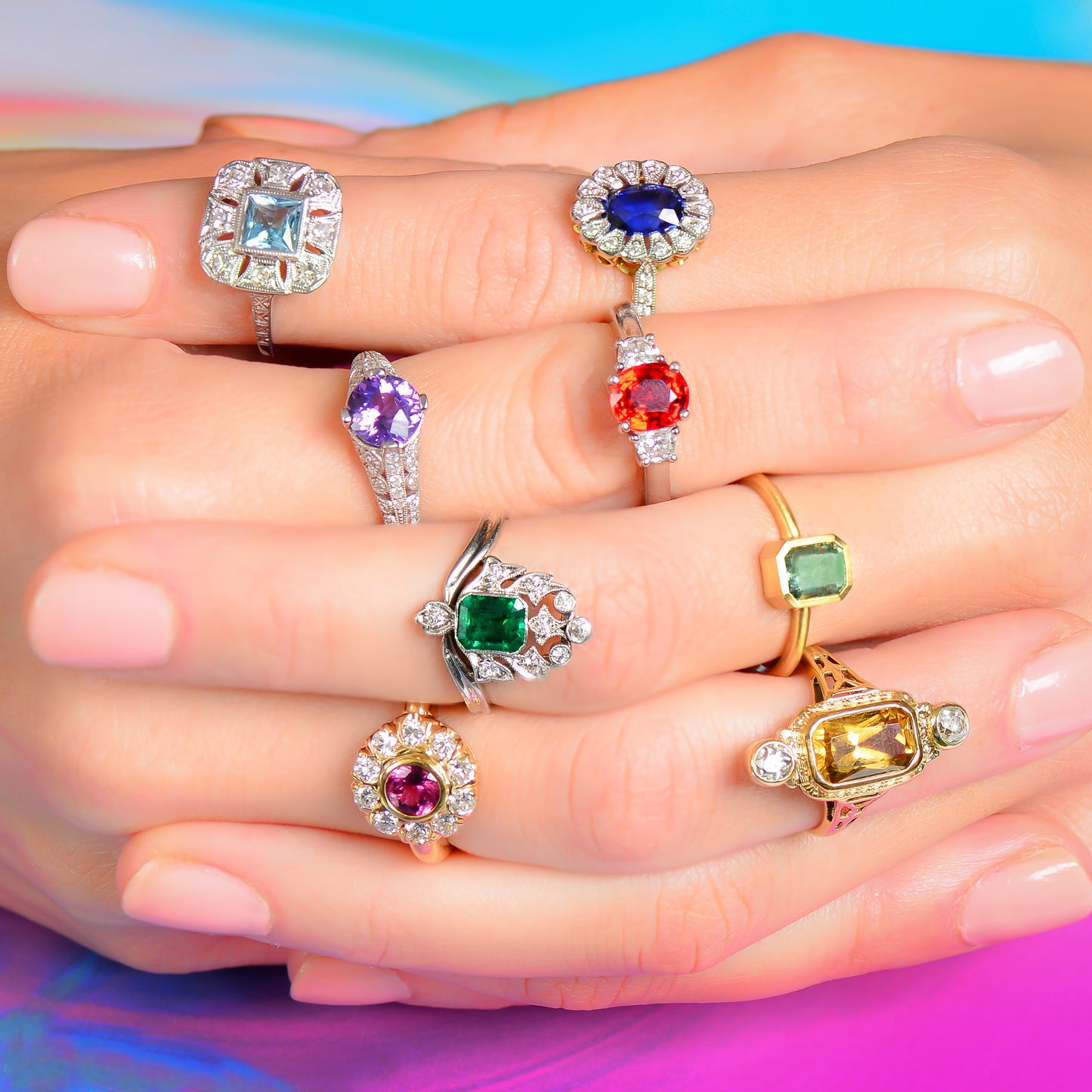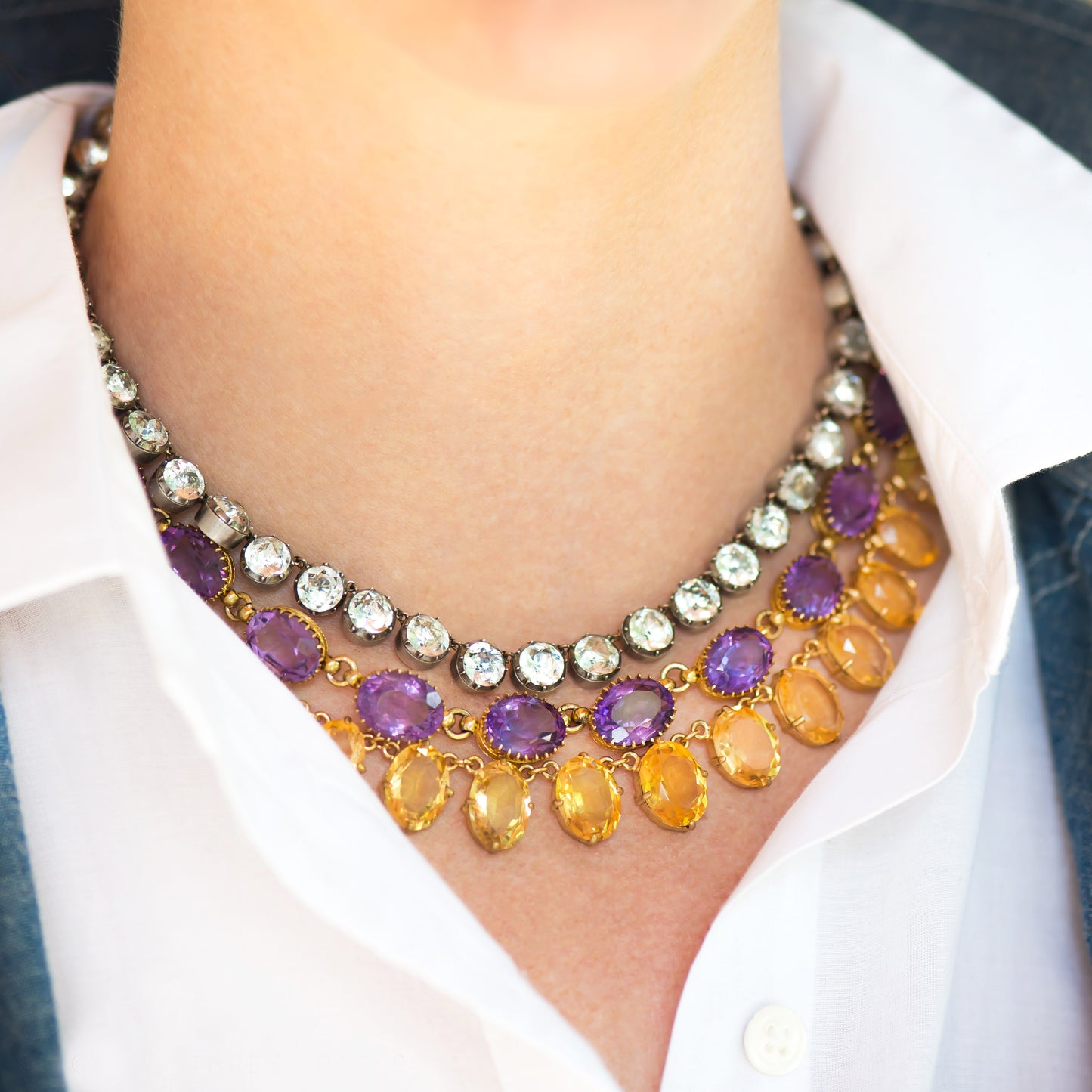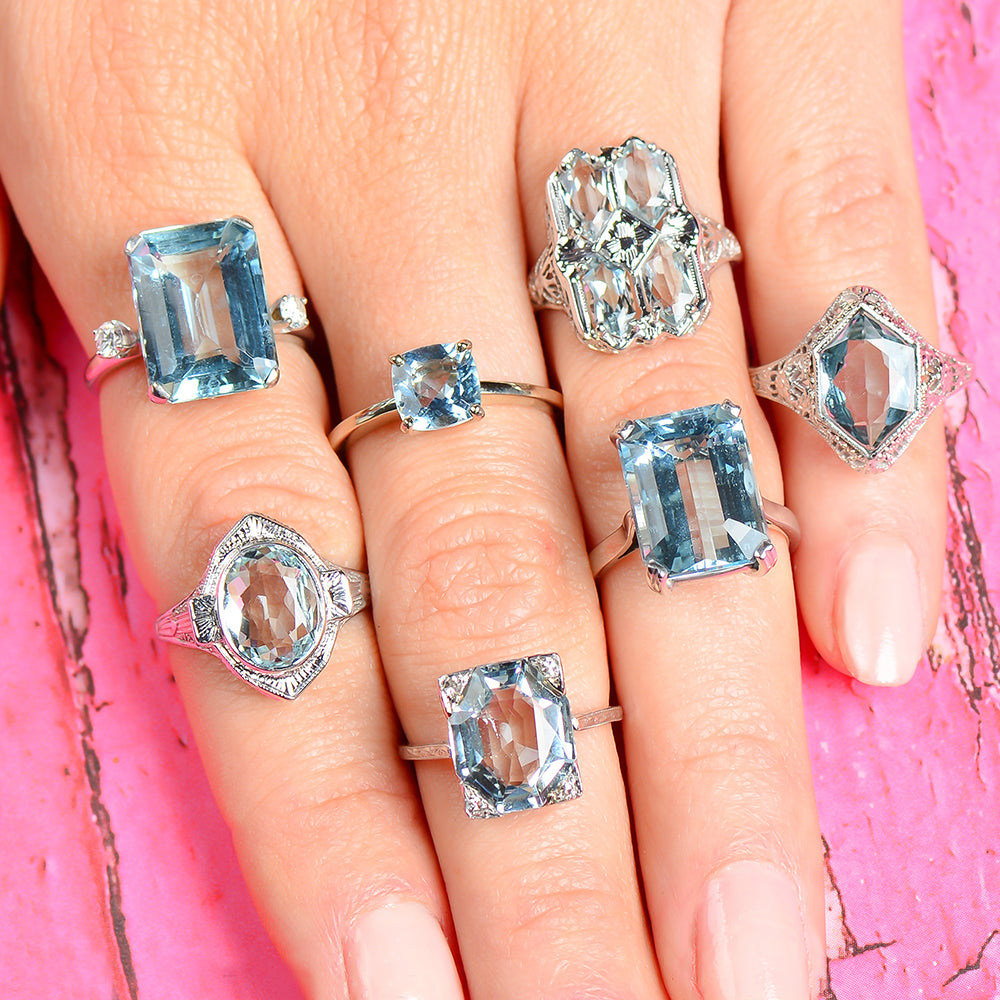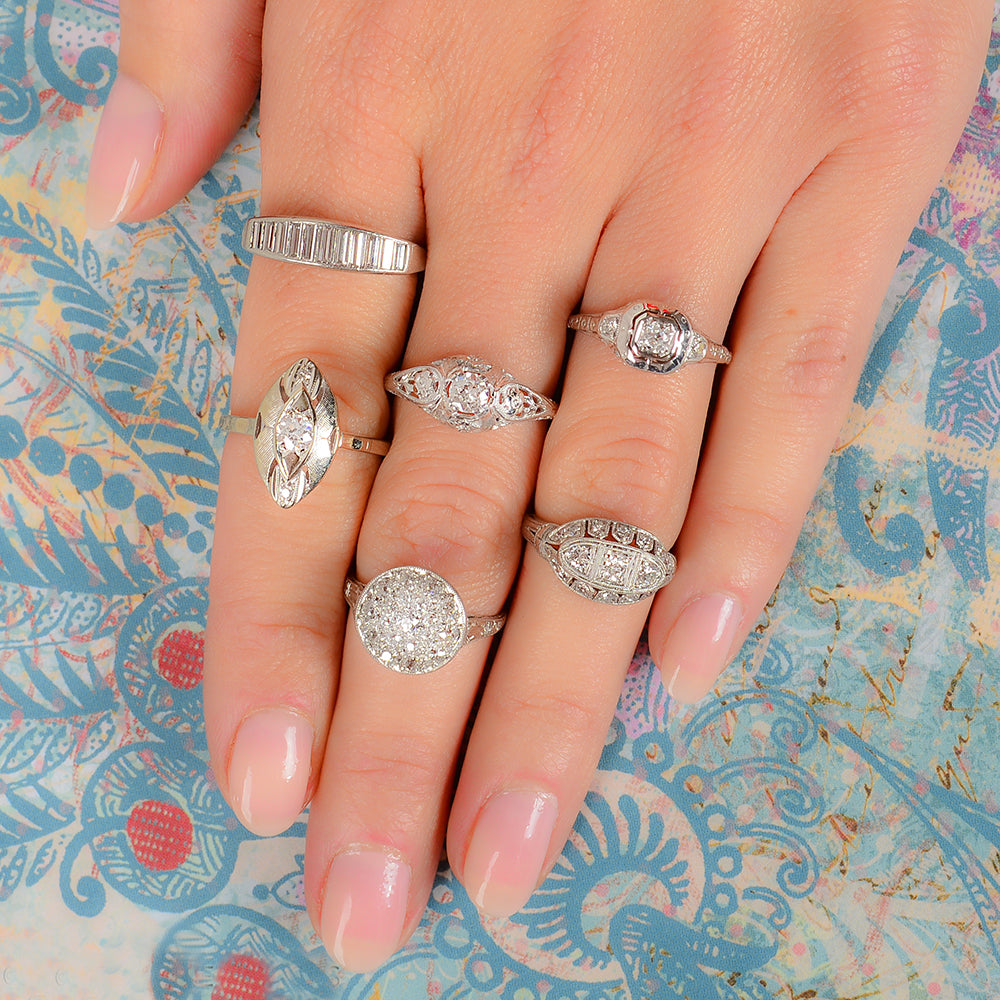
Grandeur - Eighteenth Century Chrysoberyl Pendant
$11,650.00 $14,500.00 19% off
The epitome of the spirit of the 18th century in Europe...a breathtaking chrysoberyl pendant.
As dazzling as it must have been when wrought, this lavish jewel recalls the tastes and preferences of the elite in the Iberian region.
Usually worn high on the neck on a ribbon, or as shown in our photographs, each of the 124 chrysoberyl gemstones was precisely hand-cut and then set into silver wells or channels. Upon close examination, you realize that no two stones are alike; all are distinct.
Every shape imaginable comes to life within this one antique pendant. Outlines of cushions, eyes, squares, and rectangles, near rounds, and mixes of curves and angles come together in harmony.
If you were to ask what few motifs dominated most of 18th-century jewelry and design, it is easily answered...flowers, ribbons or bows, and the teardrop. All are employed here with three flower heads, their accompanying leaves and stems, the drape of ribbons that form a bow, and a teardrop below.
Still removable, the dangle can be worn on a chain or attached to another piece of jewelry. All the gemstones are foiled beneath them for maximum refraction and sheen.
Silver is the medium used as the backdrop; its heavy weight attests to its construction, and it is entirely handmade. To the reverse, a sculptural rounded technique contains the gems. In fact, the silver was worked over the edges of the gemstones and burnished smoothly to create an exact cradle for each.
It is scarce indeed to discover this large example in its original, untouched condition outside of museum collections. Each stone is original, as are the two pendant fittings.
Historical note: Originally brought to the British Isles and Europe by the Spanish and Portuguese, the fiery gemstone is the color of pale chartreuse green, similar to that of a crystal Pontarlier glass of absinthe diluted with water. A gemstone with a high refractive index, it has remarkable shimmer and light.
Important: Avoid immersing this in water or exposing it to other liquids, cleaning products, or harsh chemicals. Steam cleaning should be avoided. Polishing with a silver cloth is recommended for the back. For the front, a gentle wipe with a soft cloth, such as those for eyeglasses, is enough to keep it dazzling.
FREE WORLDWIDE!
Lightning Fast
Most purchases ship the same day if purchased by noon Eastern.
Shipping occurs M-F and arrives M-Fri or Sat by USPS.
Shipments are anonymous for surprises and gift-giving.
DOMESTIC METHODS



FREE 2 DAY via UPS or FedEx. Also 2-4 DAY USPS (under $500).
- A physical address and phone number are required.
- IMPORTANT: A signature is required for insurance
- If missed, redelivery occurs the following day.
HOLD OPTIONS
Hold at FedEx hold locations or UPS Stores. A photo ID of the addressee is required.
USPS hold at your local post office.
UPGRADED OPTIONS CHARGES
2 Day morning delivery. Usually by 10:30 am. $35—to major areas
Overnight—$35
Priority Overnight Usually by 10:30 am—$45
Saturday Delivery—$50
INSURANCE
GRATIS! Every package is fully insured by a specialized jewelry insurance carrier. You receive a full refund right away if lost, damaged, or stolen. Contact us immediately! Remember, after shipping thousands of packages a year since 2002, problems are very rare.
HOW IS MY JEWELRY BOXED?
A lovely hand-made Italian gift box with a fabric ribbon is provided. Please refer to this page for photographs and more information.
FREE RETURN SHIPPING
If for any reason you are not happy with your purchase, even returns are free from anywhere within the US. Visit the Returns section for details. Our apologies, but due to customs forms and regulations, international buyers pay for return shipping.
INTERNATIONAL SHIPPING


Express service fee is $75, fully insured via UPS or FedEx, 2-7 day service.*
Contact us to receive an estimate for any taxes, duties, or fees.
*Custom's clearance times vary.
FREE WORLDWIDE!
Lightning Fast
Most purchases ship the same day if purchased by noon Eastern.
Shipping occurs M-F and arrives M-Fri or Sat by USPS.
Shipments are anonymous for surprises and gift-giving.
DOMESTIC METHODS



FREE 2 DAY via UPS or FedEx. Also 2-4 DAY USPS (under $500).
- A physical address and phone number are required.
- IMPORTANT: A signature is required for insurance
- If missed, redelivery occurs the following day.
HOLD OPTIONS
Hold at FedEx hold locations or UPS Stores. A photo ID of the addressee is required.
USPS hold at your local post office.
UPGRADED OPTIONS CHARGES
2 Day morning delivery. Usually by 10:30 am. $35—to major areas
Overnight—$35
Priority Overnight Usually by 10:30 am—$45
Saturday Delivery—$50
INSURANCE
GRATIS! Every package is fully insured by a specialized jewelry insurance carrier. You receive a full refund right away if lost, damaged, or stolen. Contact us immediately! Remember, after shipping thousands of packages a year since 2002, problems are very rare.
HOW IS MY JEWELRY BOXED?
A lovely hand-made Italian gift box with a fabric ribbon is provided. Please refer to this page for photographs and more information.
FREE RETURN SHIPPING
If for any reason you are not happy with your purchase, even returns are free from anywhere within the US. Visit the Returns section for details. Our apologies, but due to customs forms and regulations, international buyers pay for return shipping.
INTERNATIONAL SHIPPING


Express service fee is $75, fully insured via UPS or FedEx, 2-7 day service.*
Contact us to receive an estimate for any taxes, duties, or fees.
*Custom's clearance times vary.
 Authenticity Guaranteed
Authenticity Guaranteed
 Fast Shipping
Fast Shipping
 No Question Returns
No Question Returns

Breathtaking Engagement Rings
As distinctive as you are, every engagement and wedding ring is unique and handpicked for its aesthetics, condition, and authenticity. Filigree work, cluster or halo rings, three stones, wedding sets, diamonds or fine gemstones - you will know it when you see it.
Experience The World of The Three Graces
Trust & Honesty
Testimonials
The Three Graces adds a personal touch with absolute professionalism that makes every interaction special.
I have been buying here more than a decade. An ever-changing collection that feels curated, carefully chosen, always high quality.
It never ceases to amaze me how every lovely piece of antique jewelry is so immaculate and ageless.
